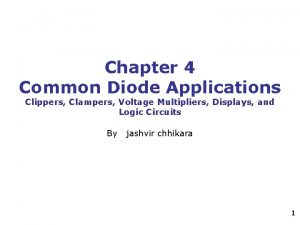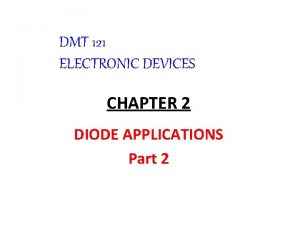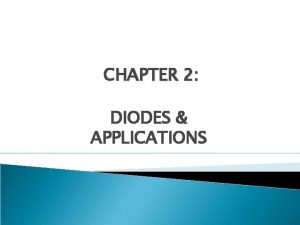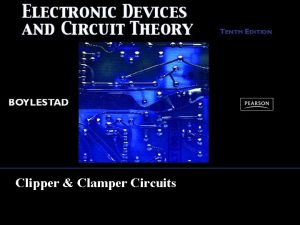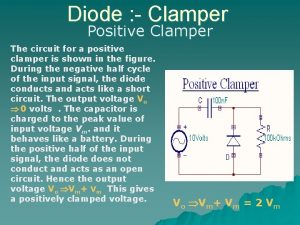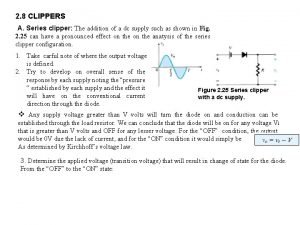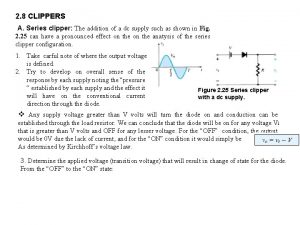Clipper and Clamper Circuits Clippers Clipper circuits also









- Slides: 9

Clipper and Clamper Circuits

Clippers ● Clipper circuits, also called limiter circuits, are used to eliminate portion of a signal that are above or below a specified level – clip value. ● The purpose of the diode is that when it is turn on, it provides the clip value ● Clip value = V’. To find V’, use KVL at L 1 ● The equation is : V’ – VB - V = 0 V’ = VB + V Vi V’ = VB + V L 1 Ø Then, set the conditions Ø If Vi > V’, what happens? diode conducts, hence Vo = V’ Ø If Vi < V’, what happens? diode off, open circuit, no current flow, Vo = Vi

EXAMPLE For the circuit shown below sketch the waveform of the output voltage, Vout. The input voltage is a sine wave where Vin = 10 sin t. Assume V = 0. 7 V

Parallel Based Clippers Ø Positive and negative clipping can be performed simultaneously by using a double limiter or a parallel-based clipper. Ø The parallel-based clipper is designed with two diodes and two voltage sources oriented in opposite directions. Ø This circuit is to allow clipping to occur during both cycles; negative and positive

Clipper – Diode in Series Figure (a)shows the input voltage of the circuit as shown in Figure(b). Plot the output voltage Vo of these circuits if V = 0. 7 V (a) (b)

Clampers ● Clamping shifts the entire signal voltage by a DC level. Ø Consider, the sinusoidal input voltage signal, v. I. Ø 1 st 900, the capacitor is charged up to the peak value of Vi which is VM. Ø Then, as Vi moves towards the –ve cycle, Ø Ø the diode is reverse biased. Ø Ideally, capacitor cannot discharge, hence Vc = VM By KVL, we get NOTE: The input signal is shifted by a dc level; and that the peak-to-peak value is the same

Clampers ● A clamping circuit that includes an independent voltage source VB. Peak value VM Ø STEP 1: Knowing what value that the capacitor is charged to. And from the polarity of the diode, we know that it is charged during positive cycle. Using KVL, Ø Ø VC + V B – V S = 0 V C = V M – V B STEP 2: When the diode is reversed biased and VC is already a constant value Ø VO – V S + V C = 0 V O = V S – VC.

EXAMPLE – clampers with ideal diode For the circuit shown in figure below, sketch the waveforms of the output voltage, Vout. The input voltage is a sine wave where Vin = 20 sin t. Assume ideal diodes. Vin

What if the diode is non-ideal? Vi C + + Vi Vo - 5 V The diode is a non-ideal with V = 0. 7 V - 10 t -4. 3 -10 -14. 3 -24. 3 ØStep 1: VC + V - VB – Vi = 0 VC = 10 + 5 – 0. 7 = 14. 3 V ØStep 2: VO – Vi + VC = 0 VO = Vi – 14. 3.
